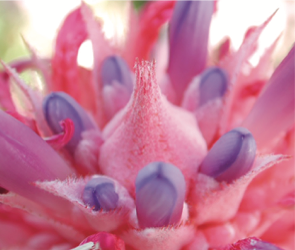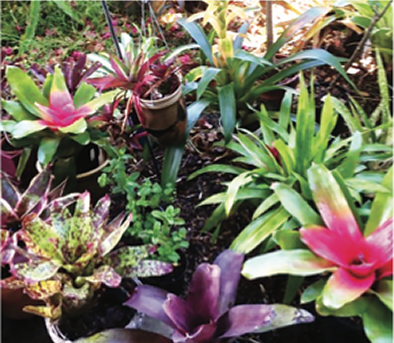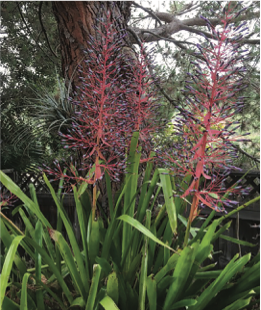Bromeliad Basics

Aechmea fasciata in bloom (Jane Auerbach)
BY NANCY NYGARD
(This article first appeared in California Garden magazine, May-June, 2022)
Bromeliads are members of the Bromeliaceae plant family; most are native to Central and South America. The variety within the Bromeliaceae family is astounding, with over 3000 species within 56 genera. The quirky Tillandsias, more commonly known as air plants; the beard-like Spanish moss, which is neither an actual moss nor from Spain; and the only edible bromeliad, the pineapple, are all members of the Bromeliaceae family.
Noted garden designer Nan Sterman declared bromeliads “the designer shoes” of plants, a worthy metaphor for this unique plant. Bromeliads are known for their fantastical, long-lasting flowers and sculptural plant shapes that would be right at home in a Dr. Seuss book. Some bromeliad varieties sport leaves with vivid color splashes, including pinks, lime greens, and magentas— distinctive colorations unmatched in the plant world.
 Bromeliads can thrive both indoors or outdoors in our Southern California Mediterranean climate and are surprisingly low care. Despite their exotic tropical appearance, bromeliads are not water hogs, needing only occasional waterings in the center cup formed by the axils (base) of the leaves. Drainage is crucial for bromeliads, as overwatering and poor drainage are frequent causes of bromeliad demise. Fertilizer needs are minimal but vary by species.
Bromeliads can thrive both indoors or outdoors in our Southern California Mediterranean climate and are surprisingly low care. Despite their exotic tropical appearance, bromeliads are not water hogs, needing only occasional waterings in the center cup formed by the axils (base) of the leaves. Drainage is crucial for bromeliads, as overwatering and poor drainage are frequent causes of bromeliad demise. Fertilizer needs are minimal but vary by species.
As for light exposure, depending on the species, bromeliads can tolerate deep shade to full sun. An easy-to-remember rule of thumb: soft leaves, soft light; hard leaves, hard light. A sunny exposure? Avoid bromeliads with easily flexible leaves and seek more rigid bromeliads. Bromeliads also appreciate excellent air circulation for optimal health.

Portea petropolitana will add a surprising spiky design element to your garden.
(Joan Herskowitz)
Nancy Nygard has been a Master Gardener since 2018.

